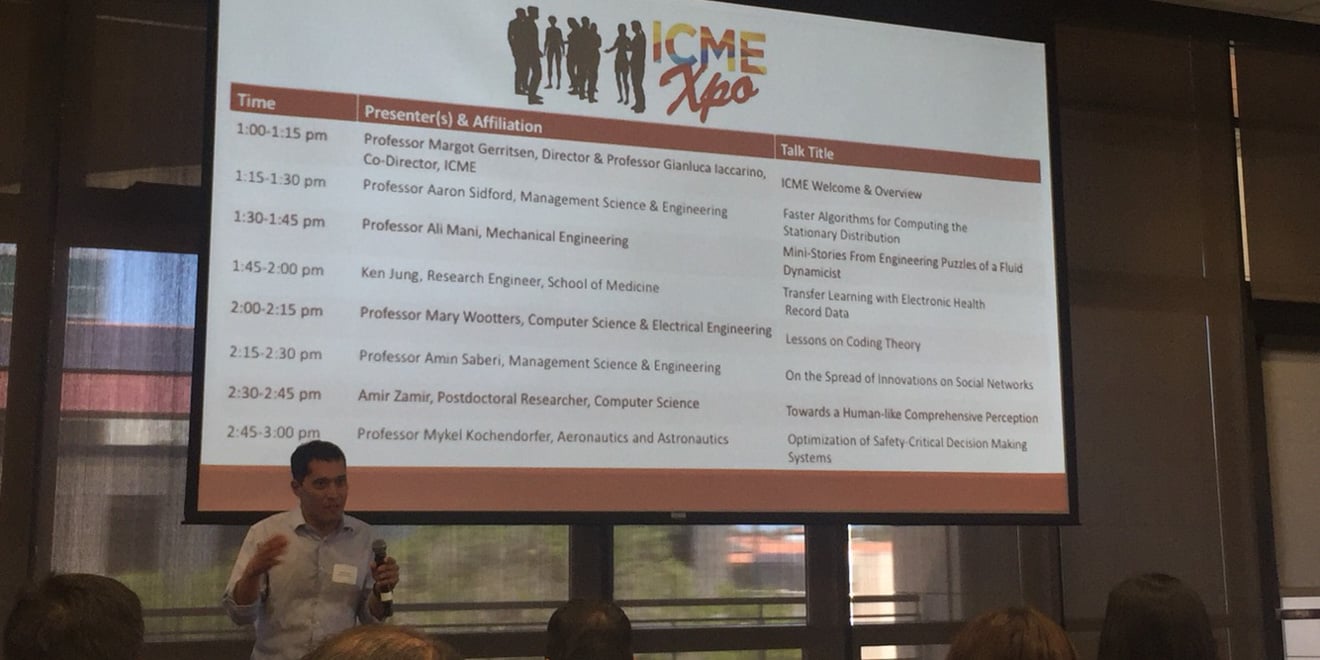Faculty of Stanford’s Institute for Computational and Mathematical Engineering (ICME) shared their cutting-edge research at Friday’s ICME Xpo, the department’s annual research symposium.
Margot Gerritsen Ph.D. ’97, associate professor of energy resources engineering and director of ICME, and Gianluca Iaccarino, associate professor of mechanical engineering and co-director of ICME, kicked off the event with an opening welcome and introduction. They were followed by a series of seven presentations on current research conducted by faculty in ICME and other engineering departments.
Afterward, attendees had the chance to see a range of work in ICME and other fields during a poster session.
The talks provided an opportunity for attendees to gain insight into the various applications of ICME’s research, such as mathematics, data science and scientific computing. Topics ranged from solar energy to understanding genetic disorders.
Aaron Sidford, assistant professor of management science and engineering, gave the event’s opening talk on faster algorithms to solve what he called “one of the most fundamental problems” in his area of study. Ali Mani M.S. ’04 Ph.D. ’09, assistant professor of mechanical engineering, followed with a presentation titled “Mini-Stories from Engineering Puzzles of a Fluid Dynamicist.” With a background in fluid dynamics and computational engineering, Mani educated the audience on how to use particles in a gas for applications like solar energy harvesting.
Ken Jung, a research engineer at the School of Medicine and one of three recipients of the ICME Seed grant, spoke about his work using electronic data to address a health issue. Jung researches familial hypercholesterolemia (FH) — a genetic disorder more commonly known as high cholesterol that causes a build-up of low-density lipoproteins at a young age and is often underdiagnosed. Jung’s lab aims to use available data in electronic health records to create a means for identifying whether or not a person has FH. In addition to sharing his research, Jung framed his presentation as a recruiting talk for ICME students to join his lab.
Mary Wootters, assistant professor of computer science and of electrical engineering, taught attendees “Lessons from Coding Theory.” Her work includes solutions to problems in communication and data storage.
“Coding and information theory for communication and storage is still a vibrant research area,” she said.
Associate Professor of Management Science and Engineering Amin Saberi gave a talk on the dissemination of social network innovations that introduced two models for the spread of a behavior or technology: an “epidemic” model and a “game dynamic” model. In the epidemic scenario, technology spreads similarly to a disease moving from individual to individual. In the game dynamics scenario, the likelihood of someone adopting a technology can be modeled as a game in which people’s choices are influenced by their neighbors’ decisions.
Amir Zamir, postdoctoral researcher in computer science and recipient of an ICME Seed grant, discussed his efforts to develop algorithms with “human-like” perception. His ongoing project involves tax taskonomy, or taskonomy, which allows computational models to learn different tasks for a more comprehensive intelligence.
The final presentation was by Mykel Kochenderfer ’02 M.S. ’03, assistant professor of aeronautics and astronautics and director of the Stanford Intelligent Systems Laboratory. Kochenderfer’s research deals with models and algorithms for intelligent decision making under uncertainty. His presentation focused on the use of a mathematical model to prevent in-air aircraft collisions. While working at Lincoln Labs, Kochenderfer designed the traffic collision avoidance system (TCAS) mandated in all commercial airplanes. The model has significantly increased air safety, and Kochenderfer himself was on the first flight test of the technology.
“I would have to say that few things are more exciting than being on a large aircraft flying at another large aircraft and hoping that this … stuff works out,” Kochenderfer said.
The event also included three presentations utilizing the ICME HANA Immersive Visualization Environment (HIVE), a 10-feet-tall by 24-feet-wide screen meant to facilitate visualization for teaching and research. Presentations featured innovations such as the Stanford Virtual Heart, a Lucille Packard Children’s Hospital initiative to harness virtual reality for science education, and the David Rumsey Map Center’s high-resolution maps.
Contact Caroline Kimmel at ckimmel ‘at’ stanford.edu.
